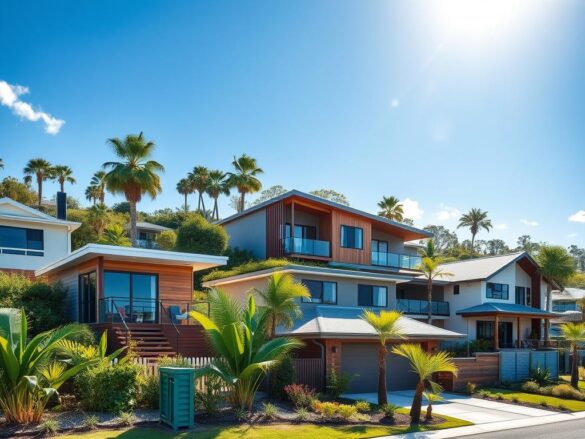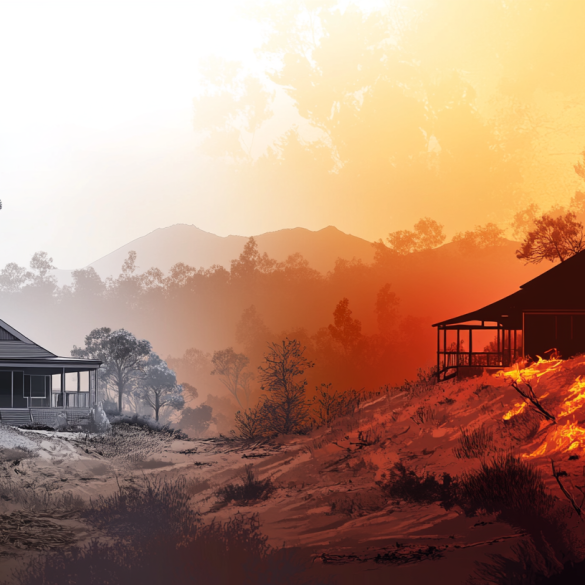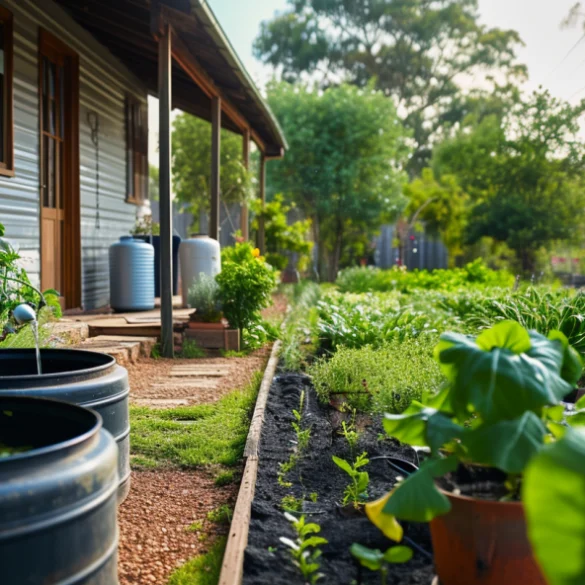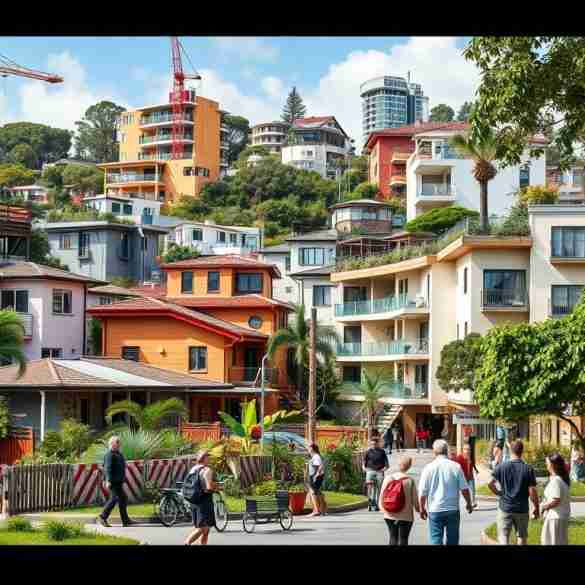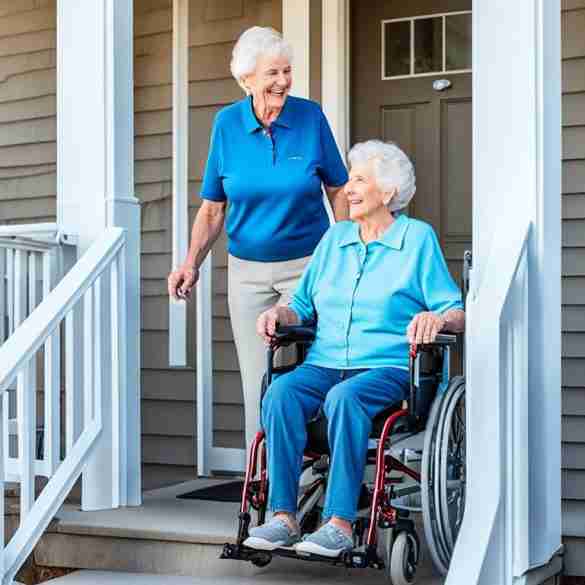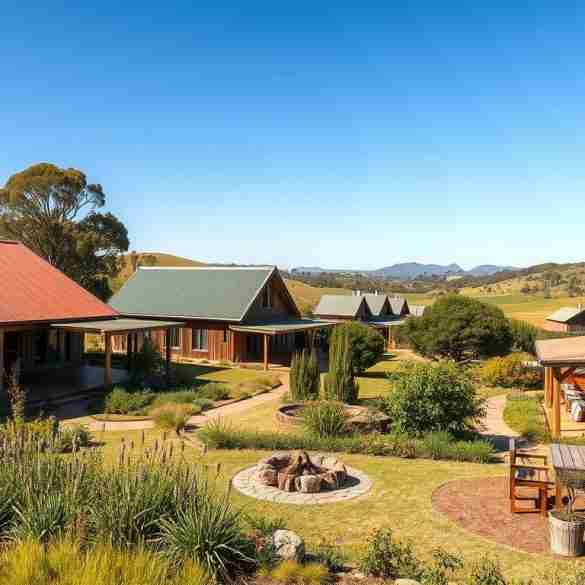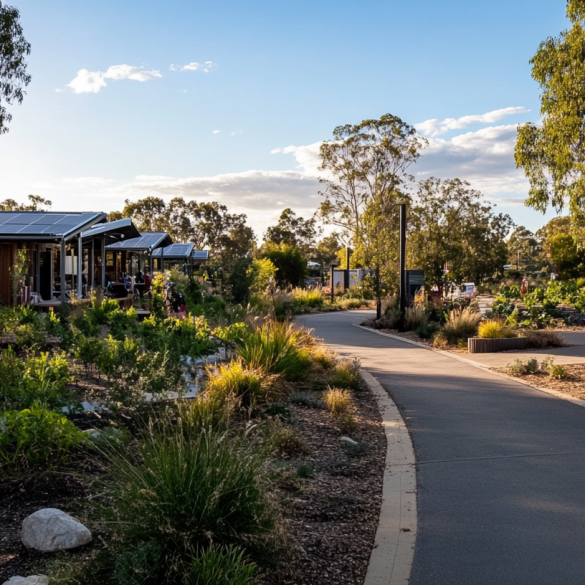Kit homes in Queensland are loved for their open, relaxed feel. They have big verandas that help them handle the hot, humid weather. These homes have a long history in Australia, starting in the 1850s.
Today, many designs mix old charm with new features. Popular designs for Kit Homes in Queensland are suitable for busy Brisbane and quiet Sunshine Coast areas.

Table of Contents
Key Takeaways
- Kit homes in Queensland, known as “Queenslanders,” feature open, relaxed living spaces with sweeping verandas.
- These homes’ design is tailored to Queensland’s unique climate, with adaptations for hot, humid days and evening thunderstorms.
- Kit homes in Australia have a rich history dating back to the 1850s, when they were first introduced in England.
- Contemporary Queensland kit home designs blend modern features with traditional aesthetics, catering to various locations and preferences.
- Kit home builders in Queensland, such as Wide Span Homes and Wholesale Homes and Sheds, offer a diverse range of customizable designs and construction options.
Overview of Kit Homes
Kit homes, also known as ‘modular’ or ‘prefab’ homes, are very popular in Queensland. They offer a unique and easy way to build your dream home. Unlike regular homes, kit homes are made off-site and then put together quickly.
What is a Kit Home?
A kit home is a pre-made house with parts like walls, floors, and roofs made elsewhere. These homes are designed to be easy to change to fit your needs and wants.
Benefits of Choosing Kit Homes
- Cost-effective: Kit homes are often cheaper than building a house from scratch.
- Reduced construction time: They can be built much faster because they’re made ahead of time.
- Customization options: You can pick many design choices to make your home your own.
Environmental Considerations
Many people want homes that are good for the planet. Kit homes often have green features. They might use solar power or other eco-friendly systems to save energy and reduce waste.
| Feature | Benefit |
|---|---|
| Alternative Energy Sources | Less money spent on energy and better for the planet |
| Efficient Insulation | Keeps your home warm or cool and uses less energy |
| Sustainable Materials | Builds your home in a way that’s kinder to the environment |
“Kit homes offer a unique blend of affordability, customization, and environmental consciousness, making them an increasingly popular choice for homebuyers in Queensland.”
As more people want homes that are good for the planet and save money, kit homes are becoming more important. They are set to change how homes are built in Queensland.
The Appeal of Queensland Kit Homes
Queensland’s climate and lifestyle have shaped kit homes. They mix modern features with traditional Queenslander looks. These Queenslander Kit Homes and Tropical Kit Home Designs meet the region’s needs, offering a unique living experience.
Unique Climate Adaptations
Kit homes in Queensland are made for the subtropical climate. They have wraparound verandahs, high ceilings, and special windows and doors. This design keeps homes cool and comfy all year.
The homes use strong, weather-proof materials. This helps them stand up to Queensland’s extreme weather.
Emphasizing Outdoor Living
Queenslander kit homes focus on outdoor living. They have big, open designs that merge inside and outside. Verandahs, patios, and decks are perfect for entertaining and relaxing outdoors.
This design lets homeowners enjoy the Queensland lifestyle fully.
Cultural Influences in Design
The design of Queensland kit homes honors the state’s culture. They use timber framing, corrugated iron roofing, and timber or weatherboard cladding. These elements pay tribute to traditional Queenslander homes.
Locally sourced materials show the region’s resources and craftsmanship. This blend of modern and traditional makes these homes truly special.
They offer a genuine and personalized living experience. It celebrates Queensland’s rich cultural heritage.
Popular Kit Home Styles
Queensland kit homes come in many styles. You can find modern homes with open plans or traditional Queenslander designs. These homes are perfect for anyone, whether you love the beach or classic looks.
Contemporary Design Features
The Avalon is a modern kit home. It has an open-plan layout and blends indoor and outdoor spaces well. Kit Homes Sunshine Coast and Kit Homes Toowoomba fans will love its sleek design.
Traditional Queenslander Aesthetics
The Chatsworth kit home honors the Queenslander style. It has a unique verandah and focuses on views and air flow. If you love the classic Queenslander look, the Chatsworth is for you.
Coastal and Beachfront Homes
The Coral Cove kit home is great for beach lovers. It has big windows and decks for enjoying the view. Kit Homes Sunshine Coast and coastal areas will love its indoor-outdoor feel.
“The kit home landscape in Queensland is brimming with captivating options, catering to a wide range of preferences and lifestyles.”
| Kit Home Design | Key Features | Ideal Location |
|---|---|---|
| Avalon | Open-plan layout, seamless indoor-outdoor living | Kit Homes Sunshine Coast, Kit Homes Toowoomba |
| Chatsworth | Verandah extension, traditional Queenslander aesthetics | Queensland, heritage-rich areas |
| Coral Cove | Large windows, expansive decks, beachfront living | Kit Homes Sunshine Coast, coastal regions |
Building Regulations in Queensland
Building kit homes in Queensland means following local building codes. You also need to get the right permits and approvals. This can take months, with steps like council submissions and notices. Companies like Kit Home Builders Queensland and Kit Homes Brisbane help with plans, engineering reports, and energy certificates.
Understanding Local Building Codes
Queensland’s building rules aim for safe, quality homes. You must know the rules for your area. These include:
- Structural integrity
- Energy efficiency
- Accessibility
- Bushfire-resistant design
- Flood-prone zone considerations
Talking to Kit Home Builders Queensland can guide you through these rules. They ensure your kit home meets all standards.
Navigating Permits and Approvals
Getting permits for a kit home in Queensland takes time. You’ll need to send plans and reports to the council. This includes:
- Development application
- Building permit
- Plumbing and drainage approvals
- Electrical and gas certifications
- Bushfire attack level (BAL) assessment
Experienced Kit Homes Brisbane suppliers can make this easier. They know what paperwork is needed and help with submissions.
“Navigating the building regulations and approval process in Queensland can be daunting, but with the right guidance, kit home projects can be completed efficiently and in compliance with local requirements.”
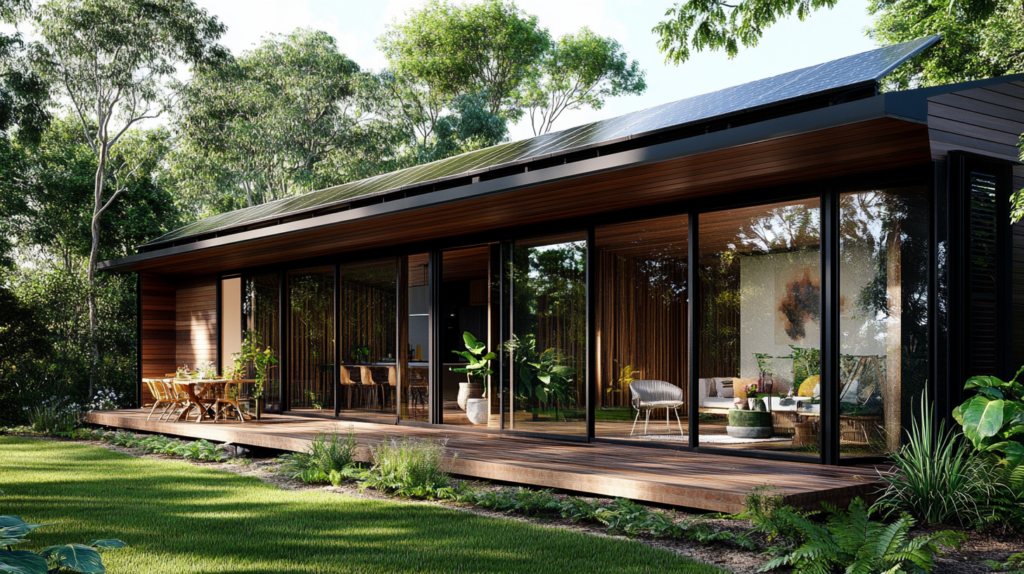
Customization Options for Kit Homes
Building your dream home in Queensland is easy with Affordable Kit Home Plans and Modular Kit Home Designs. They offer many customization options. You can make your home reflect your unique lifestyle and preferences.
Modifying Floor Plans
Buyers can change existing floor plans or use their designs. You can add an extra bedroom, a media room, or a bigger veranda. For example, the Coral Cove design can have 3-5 bedrooms. The Hazledean kit home has 5+ bedrooms, multiple bathrooms, and a double car garage on 609m2.
Selecting Materials and Finishes
You can also pick the materials and finishes for your kit home. This lets you match your home to the local climate and your style. Smooth hardi-plank cladding is popular in Queensland for its durability and ease of installation.
Steel frame homes with hardi-plank cladding are affordable and sustainable. The Rubyvale design has dual bi-fold doors, a spacious ensuite, and a dedicated media room. It’s perfect for modern living.
With these options, Affordable Kit Home Plans and Modular Kit Home Designs in Queensland let you create a unique home. Your home will reflect your individual needs and preferences.
“The size and designs of kit homes have evolved significantly in the last century, offering homeowners in Queensland a wide range of customization possibilities.”
| Design | Bedrooms | Bathrooms | Additional Features |
|---|---|---|---|
| Coral Cove | 3-5 | Multiple | Expansive outdoor access |
| Hazledean | 5+ | Multiple | Double car garage on 609m2 area |
| Rubyvale | Flexible | Spacious ensuite | Bi-fold doors, media room |
| Silkwood | Up to 3 | 2 | Ample living, lounging, dining, and kitchen areas |
Eco-Friendly Kit Home Designs
Sustainable Home Magazine talks about the rise of eco-friendly kit homes in Queensland. These homes use green building methods and save energy. They make living spaces better for the planet.
Sustainable Building Practices
Eco-friendly kit homes in Queensland use materials like renewable and recycled ones. This choice cuts down on carbon emissions and helps the local economy. They also aim to waste less and use energy more wisely.
Energy Efficiency Considerations
Energy saving is a big deal in these homes. They might use solar power to cut down on fossil fuel use. This saves money on bills and is better for the environment.
The Queensland government supports these homes with rebates and incentives. This makes eco-friendly kit homes more appealing. It helps make Queensland a greener place.

“Eco-friendly kit home designs in Queensland seamlessly integrate sustainable building practices and innovative energy efficiency considerations to create environmentally-conscious living spaces.”
Budgeting for Your Kit Home
Thinking about a kit home in Queensland? It’s key to know the costs upfront and hidden. Affordable Kit Home Plans and Kit Homes Brisbane can save money compared to building from scratch. But, the price can change based on size, custom features, and getting the land ready.
Understanding Costs Involved
Kit houses can cost as little as $10 per square foot. The average is $40-$60 per square foot. A basic 3-bedroom kit home starts at $53,400.
For more, like the MACCA model from Imagine Kit Homes, a 5 bedroom/3 bathroom/3 car prefab, expect to pay $332,255 AUD. The Aitape model from Valley Kit Homes costs $132,530 (elevated floor) or $127,430 (concrete floor). The Brielle model is $123,550 (elevated floor) or $86,560 (concrete floor).
Hidden Expenses to Anticipate
- Soil testing, contour survey, and BAL report, essential pre-construction requirements in Queensland
- Insurance coverage, power, water, sewerage treatment, and site clearing
- Delivery of materials in three stages, highlighting the logistical aspect
- Electrical, plumbing, roofing, and painting services during construction
- Finishings such as cabinets, sinks, bathroom fixtures, white goods, waterproofing, tiles, floor coverings, and paint
- Additional expenses for window coverings, light fittings, furniture, decor, landscaping, and house cleaning
Despite these costs, Kit Homes Brisbane can still save money. They also have a smaller environmental impact. Plus, you might get government grants or investment incentives.
| Model | Price | Details |
|---|---|---|
| MACCA | $332,255 AUD | 5 bedroom/3 bathroom/3 car prefab structure |
| Aitape | $132,530 (elevated floor) $127,430 (concrete floor) | Prefab kit home from Valley Kit Homes |
| Brielle | $123,550 (elevated floor) $86,560 (concrete floor) | Steel frame kit home with weatherboards from Valley Kit Homes |
| Kilcunda | Starting from $138,668 | One storey, 4 bedroom, 2.5 bathroom prefab house from Imagine Kit Homes |
“Kit homes are a smart investment choice for designing a dream home within budget constraints.”
Sourcing Materials for Kit Homes
Building a kit home in Queensland needs the right materials. You can pick local or imported parts. Local materials fit the climate better and save on transport. But, the quality of the materials is most important.
Local vs. Imported Supplies
Many kit home builders in Queensland use local materials. This supports the local economy and fits the climate. Some choose imported parts for more design options or special features.
Quality Considerations
Quality is key, no matter where the materials come from. Suppliers like Wide Span Homes focus on top-quality parts. They meet Australian standards, ensuring durability and energy efficiency in Queensland’s climate.
| Material Source | Advantages | Considerations |
|---|---|---|
| Local Supplies |
|
|
| Imported Supplies |
|
|
Choosing materials for a kit home in Queensland has its pros and cons. Local and imported options both have benefits. It’s important to work with a reliable kit home builder in Toowoomba or Queensland. They can help choose the best materials for a quality, durable, and sustainable home.
Working with Kit Home Suppliers
Building your dream kit home in Queensland needs the right supplier. Prestige Kit Homes offers great prices, quality materials, and lots of support. But, it’s key to compare suppliers to find the best value and service.
Choosing the Right Company
Start by looking at prices, quality, and the supplier’s reputation. Companies linked to the HIA or MBA show they care about quality. Also, check what past customers say to see if the supplier is good at helping and making customers happy.
Assessing Customer Service and Support
- Ask if the supplier is available for questions and help during your project.
- Find out about their warranty and how they handle problems.
- See if they offer extra services like design help or site prep.
- Check their delivery times and if they can fit into your schedule.
By carefully looking at kit home suppliers in Queensland, you can find a great partner. They should offer quality products and good service. This makes building your kit home easy and successful.
| Feature | Prestige Kit Homes | Kline Kit Homes |
|---|---|---|
| Warranty | 50-year warranty on steel frames | 50-year warranty on steel frames |
| Sustainability | HIA Green Smart accredited | HIA Green Smart accredited |
| Footing System | Blade Pile system with lower costs | Blade Pile system with lower costs |
| Customer Support | Support during and after construction | Support during and after construction |
Finding the right kit home supplier in Queensland is key to your project’s success. By doing your homework and comparing, you can find a supplier that offers quality and the support you need to build your dream home.
DIY vs. Professional Assembly
Homeowners in Queensland can choose between DIY or hiring professionals for kit homes. Each choice has its own benefits and things to think about.
Pros and Cons of DIY Building
DIY building can save money. But, it takes a lot of time and skill. The National Association of Steel-Framed Housing Australia (NASH) says over 12.5% of new homes use steel framing.
DIY builders might finish a project in 90 days. But, big custom homes can take over 2 years. It’s important to be precise to avoid building problems. About 40% of DIY projects go over budget.
When to Hire Professionals
Hiring pros ensures quality and can save time, especially for complex designs. Rent.com.au found that professional kit homes have better rental yields. They also attract better tenants.
Professional builders might cost more upfront. But, they save time and stress in the long run. They handle all the paperwork and ensure the home meets building codes.
“Precision is crucial in steel frame construction, small measurement errors when securing frame pieces can affect the structural integrity of the building, emphasizing the need for attention to detail.”
Maintenance and Longevity of Kit Homes
Keeping your [Queenslander Kit Homes] or [Energy-Efficient Kit Homes] in Queensland in good shape is key. The area’s tough weather, especially by the coast, means you need to take care of your home. This helps keep it strong and working well for years.
Regular Maintenance Tips
Here are some tips to keep your kit home in great shape:
- Check and protect any wood parts, like siding or beams, from the weather and rot.
- Make sure your home breathes well, especially where moisture can build up. This stops mold and mildew.
- Keep your energy-saving features, like insulation and heating/cooling, in good working order. This saves money and energy over time.
Long-term Durability Insights
Choosing the right materials and finishes for your [Queenslander Kit Homes] or [Energy-Efficient Kit Homes] helps them last longer. Ecoliv says modular homes can be just as strong and efficient as traditional ones.
“Modular homes like those built by Ecoliv are a thoughtful investment in quality and sustainability, often comparable in price to traditional homes.”
Building your kit home with quality materials means it will save you money on energy and upkeep. As [Sustainable Home Magazine] points out, modular homes are built to last, just like traditional ones. They offer stability, longevity, and value.
Future Trends in Kit Home Designs
The kit home market in Queensland is changing fast. Now, people want homes that save energy and are good for the planet. They look for homes that are both green and cost-effective over time.
Innovations in Sustainability
Kit homes in Queensland are using new, green materials. Recycled timber, bamboo, and hempcrete are becoming popular. These materials help reduce harm to the environment and make homes look unique.
These homes also come with energy-saving features. Solar panels, systems to collect rainwater, and better insulation are common. Together, they make these homes leaders in eco-friendly living.
Smart Home Technologies in Kit Homes
Smart home tech is becoming a big part of kit homes in Australia. Features like automatic lights, temperature control, and security systems are now common. Even appliances can be controlled from afar.
This smart tech makes kit homes more efficient and convenient. It also makes them more appealing to buyers. They want homes that are both modern and easy to use.

